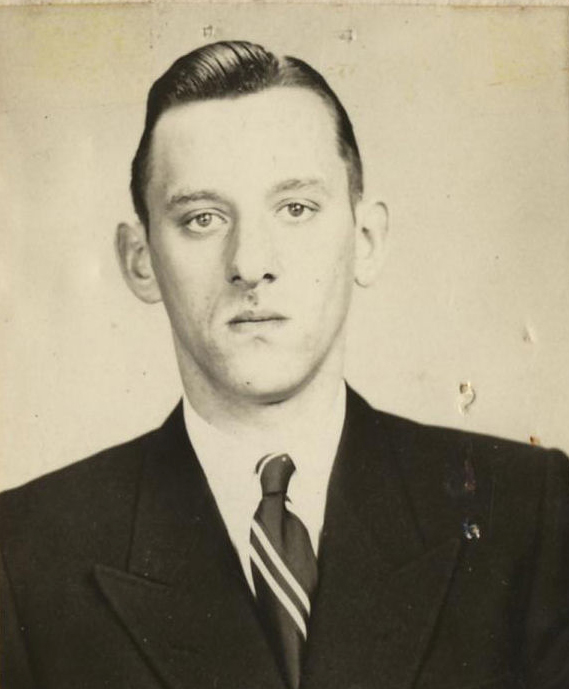Karl Silberbauer
Karl Silberbauer was an SS man and a policeman. He led the arrest team that raided Prinsengracht 263 on 4 August 1944 and arrested the people in hiding.
Karl Silberbauer was trained as a machine fitter. He was a soldier from 1931 to 1935 and joined the Vienna police in 1937.[1] He joined the SS and on 23 July 1943 was given the rank of Oberscharführer.[2] This corresponds to the NCO grade sergeant 1st class.[3] In the spring of 1944 he was mentioned in an Amsterdam police report as Hauptscharführer, one rank higher and comparable to sergeant-major.
In November 1943, his superiors transferred him to the Sicherheitspolizei in The Hague, based in the Aussenstelle in Amsterdam. When he had a motorcycle accident on 9 October 1944 near Schiphol Airport, he sustained such injuries that he stayed in a field hospital in Amsterdam until February 1945. Then he went back to Austria and was able to return to the Viennese police.[4]
According to various post-war indictments, he was guilty of mistreating detainees in the years 1941 - 1943. For this, he received a one-year prison sentence in 1946.[5] Some of the accusations were retracted later.[6]
In 1963, Simon Wiesenthal succeeded in tracking down Silberbauer and identifying him as the man who had participated in the raid on the Secret Annex on 4 August 1944.[7] After Telegraaf reporter Jules Huf had interviewed him, insinuations against Wim van Maaren appeared in the newspaper.[8] In a first document that Silberbauer wrote for his superiors before the case became public, there was no mention of betrayal by the warehouse employee. In this document he also stated that he would have forgotten Anne Frank long ago if the appearance of her diary had not been accompanied by so much publicity. He also said that after most of the Jews had left Amsterdam, he had become involved in research into clandestine radios and criminal acts against German interests.[9]
As far as is known, there are nine cases in the Netherlands in which sources show Silberbauer's involvement. An overview (PDF - Dutch only) accompanying this entry shows that only two of these nine cases involved Jewish people in hiding, and that one of these was encountered by chance. According to these sources, tracking down this category of people was not his main activity.
Source personal data.[10]
Footnotes
- ^ WStLA, Volksgericht, Vg Vr 288/1952: Proces-verbaal 14 september 1945, 15.30.
- ^ WStLA, Volksgericht, Vg Vr 288/1952: Uittreksel personeelsdossier K. Silberbauer, blad 2.
- ^ Nederlands Instituut voor Militaire Historie, Ministerie van Defensie: Email van drs. E. Rossmeisl aan Gertjan Broek (Anne Frank Stichting), 11 maart 2016.
- ^ Anne Frank Stichting (AFS), Anne Frank Collectie (AFC), map ‘Staatsanwaltschaft’/Proces 1964: Rapport Dr. Wieinger, Ministerie van Binnenlandse Zaken (Oostenrijk), 7 augustus 1963.
- ^ WStLA, Volksgericht, Vg Vr 288/1952: Publicatie vonnis in Wiener Zeitung, No. 204, 3 september 1946.
- ^ AFS, AFC, map ‘Staatsanwaltschaft’/Proces 1964: Rapport van Dr. Köck, Ministerie van Binnenlandse Zaken (van Oostenrijk), 19 december 1963, p. 3-5.
- ^ Simon Wiesenthal, 'Naschrift bij het dagboek van Anne Frank', in: Moordenaars onder ons: uit de dossiers van Simon Wiesenthal; bew. door Joseph Wechsberg, Amsterdam [etc.]: Elsevier, 1963.
- ^ See: Rosemary Sullivan, The betrayal of Anne Frank: a cold case investigation, New York, NY: Harper, 2020, p. 190-197.
- ^ AFS, AFC, map ‘Staatsanwaltschaft’/Proces 1964: ‘Bericht’ K. Silberbauer, 21 augustus 1963.
- ^ Wikipedia: Karl Silberbauer.
Digital files (1)
Silberbauer in Nederland
Kort overzicht van zaken waar Silberbauer tijdens zijn stationering in Amsterdam bij was betrokken.
Publiek domein.
